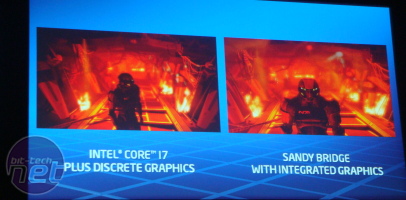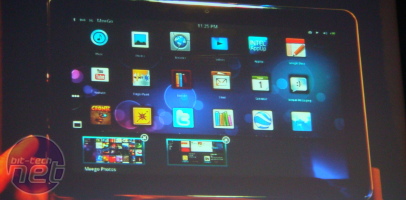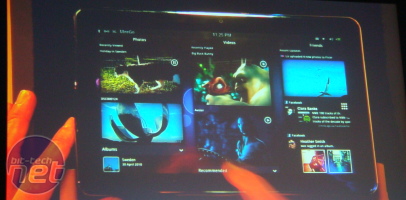Intel's Computex 2010 Keynote: Atom Everywhere
June 10, 2010 | 16:21

In the middle of Computex 2010, Intel unleashed four hours of keynotes and briefing meetings - it covered a lot of ground. While some of it was padding, there were quite a few highlights, including talk about Sandy Bridge, wireless displays and of course, Atom.
[break]
Sales are fine and despite the global economic downturn, Intel claimed PC and laptop sales were pretty consistent. It put this down to the fact once you have one, it becomes a necessity, so should it fail or become obsolete you have to buy a new one. While we simply can't do without our gaming PC, laptop, smartphone and HTPC does does Intel's belief really work for more "disposable" products such as netbooks? Or will it be replaced with a different form factor?
Wireless Display (WiDi for short) will be integrated into some laptops in the next round of refreshes. The technology is there, and the WiDi TV receivers are quite cheap and nimble, and multiple laptops can be hooked up to a single receiver as well.
Sandy Bridge will "knock your socks off" apparently. Intel claims it's revolutionary not evolutionary, as it balances CPU, graphics and power consumption in a single 1.12Bn transistor monolithic 32nm chip.
Despite being a quad-core, eight-thread CPU, just like current generation CPUs, Intel claims we should be seeing "40-50 per cent performance improvements with Sandy Bridge".
The integrated GPU in Sandy Bridge should be taken seriously, says Intel, as it claimed it's as fast as a "current mainstream discrete [mobile] graphics chip." We saw Mass Effect 2 running at "full detail levels" at 1,280 x 720 and yes, from a distance it looked smooth, but we weren't enlightened with performance numbers or DirectX support level details.
One impressive and funny demo Intel showed to demonstrate Sandy Bridge CPU-GPU performance was real-time facial recognition, rendering and animating an avatar mapped to the face of an actor. Ultimately our cynicism got the better of us, though: there's only one thing this technology would really be used for: men pretending to be women in online gaming.
Some codenames for you: Yule River is the mobile platform of Sandy Bridge, due mid-next year. Oak Trail products will arrive Q1 next year, and it's being positioned between Moorestown (the SoC targeted at phones) and Pine Trail (the full Atom / netbook platform).
The plethora of codenames is due to the fact Intel sees Atom as having a part to play in a huge range of devices, from traditional laptops and netbooks to phones, TVs and all kinds of portable internet tablets. Whatever gadget suits your life style, you should be able to find it. That concept might be is exciting, but it also results in a bewildering array of possibilities: how do you know what's right for you? Surely this is why people trust brands and easy, directed choices (Apple products and its one size fits all).
Intel had a go at software developers for not being conscientious enough to understand how to develop for low power CPUs. It explained that often the software was wasting CPU cycles or it kept asking "are you asleep?" instead of just remaining idle and letting it sleep.
We had some hands-on time with MSI's Wind Pad that uses the latest Moorestown CPU and a full fat Windows 7 Starter, and promptly came to one conclusion: don't buy a Windows 7 tablet. Put up against an iPad and it looks plain awful.
MeeGo seems to be shaping up well, though. We tried the Alpha it worked nicely, even in its early state.
MeeGo is a cross between PS3's left-right/up-down menu scrolling and Android's widgets, but with an option for iPad style icons instead at the touch of a button. The UI already has all the wizzy smooth transition animations people love though, which is a good start.
[break]
Sales are fine and despite the global economic downturn, Intel claimed PC and laptop sales were pretty consistent. It put this down to the fact once you have one, it becomes a necessity, so should it fail or become obsolete you have to buy a new one. While we simply can't do without our gaming PC, laptop, smartphone and HTPC does does Intel's belief really work for more "disposable" products such as netbooks? Or will it be replaced with a different form factor?
Wireless Display (WiDi for short) will be integrated into some laptops in the next round of refreshes. The technology is there, and the WiDi TV receivers are quite cheap and nimble, and multiple laptops can be hooked up to a single receiver as well.
Sandy Bridge will "knock your socks off" apparently. Intel claims it's revolutionary not evolutionary, as it balances CPU, graphics and power consumption in a single 1.12Bn transistor monolithic 32nm chip.
Despite being a quad-core, eight-thread CPU, just like current generation CPUs, Intel claims we should be seeing "40-50 per cent performance improvements with Sandy Bridge".
The integrated GPU in Sandy Bridge should be taken seriously, says Intel, as it claimed it's as fast as a "current mainstream discrete [mobile] graphics chip." We saw Mass Effect 2 running at "full detail levels" at 1,280 x 720 and yes, from a distance it looked smooth, but we weren't enlightened with performance numbers or DirectX support level details.
One impressive and funny demo Intel showed to demonstrate Sandy Bridge CPU-GPU performance was real-time facial recognition, rendering and animating an avatar mapped to the face of an actor. Ultimately our cynicism got the better of us, though: there's only one thing this technology would really be used for: men pretending to be women in online gaming.
Some codenames for you: Yule River is the mobile platform of Sandy Bridge, due mid-next year. Oak Trail products will arrive Q1 next year, and it's being positioned between Moorestown (the SoC targeted at phones) and Pine Trail (the full Atom / netbook platform).
The plethora of codenames is due to the fact Intel sees Atom as having a part to play in a huge range of devices, from traditional laptops and netbooks to phones, TVs and all kinds of portable internet tablets. Whatever gadget suits your life style, you should be able to find it. That concept might be is exciting, but it also results in a bewildering array of possibilities: how do you know what's right for you? Surely this is why people trust brands and easy, directed choices (Apple products and its one size fits all).
Intel had a go at software developers for not being conscientious enough to understand how to develop for low power CPUs. It explained that often the software was wasting CPU cycles or it kept asking "are you asleep?" instead of just remaining idle and letting it sleep.
We had some hands-on time with MSI's Wind Pad that uses the latest Moorestown CPU and a full fat Windows 7 Starter, and promptly came to one conclusion: don't buy a Windows 7 tablet. Put up against an iPad and it looks plain awful.
MeeGo seems to be shaping up well, though. We tried the Alpha it worked nicely, even in its early state.
MeeGo is a cross between PS3's left-right/up-down menu scrolling and Android's widgets, but with an option for iPad style icons instead at the touch of a button. The UI already has all the wizzy smooth transition animations people love though, which is a good start.

MSI MPG Velox 100R Chassis Review
October 14 2021 | 15:04









Want to comment? Please log in.